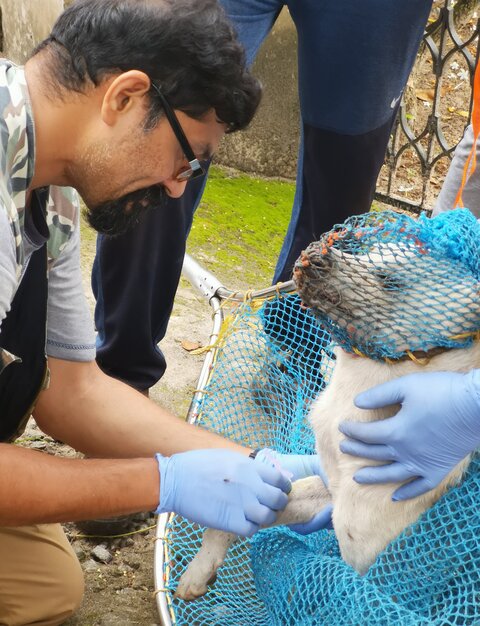How to eliminate rabies: why vaccinating man’s best friend is man’s best hope

Rabies when left untreated kills 10,000s of people each year. The virus has been targetted by the international community for elimination by 2030. Imperial College London's Christl Donnelly explains why giving rabies vaccinations is our best hope of achieving this.
In 2015, international organisations – including the World Health Organization and the World Organization for Animal Health – agreed to an ambitious, but achievable common goal: to end human deaths due to canine rabies by 2030.
All mammals can become infected with the rabies virus, and rabies is present on every continent except Antarctica. This can sound overwhelming. However, up to 99% of human rabies cases result from human dog bites. So what can be done to keep ‘man’s best friend’ from transmitting this fatal virus? Vaccination!
The first rabies vaccine was developed by Louis Pasteur in 1885.
In terms of direct protection, there are safe and effective pre- and post-exposure vaccines available for humans. However, vaccinating dogs is the most cost-effective strategy for protecting people from rabies. International guidelines make clear that mass vaccination campaigns should vaccinate at least 70% of the dog population to stop both dog-to-human and dog-to-dog transmission of the virus. However, for some groups of animals 100% vaccination is required, for example, all pet dogs, cats and ferrets travelling into the UK.
Pierre Nouvellet and I have worked with colleagues on rabies in both African domestic dog populations and Italian fox populations. Happily, the rabies vaccine works in foxes as well as dogs, although the way vaccines are delivered is different. Fox vaccination is typically delivered orally through fox-tempting baits in which the vaccine is hidden within a tasty snack!
Achieving 70% vaccination in domestic dog populations isn’t always easy. To help better understand the feasibility of this , the Wellcome Trust is supporting the PhD studies of Imperial's Sreejith Radhakrishnan (with support from myself and Pierre Nouvellet) to vaccinate 70% of selected dog populations in India. There is currently very little information on dog populations in India and what proportion are truly free-ranging. Sree is studying dog ownership patterns in two study sites in Kerala, India, where he is conducting dog vaccination campaigns and estimating the proportion of the local dog population that has been vaccinated.
Vaccinating dogs is straightforward for those accompanied by their owners who can restrain them during vaccination, avoiding the need for sedation. However free-ranging/stray dogs have to be captured (either using box-traps or with the help of trained dog-catchers) to allow vaccination to be undertaken safely.
Sree is a veterinary surgeon and has worked in the Department of Animal Husbandry and the Department of Forests and Wildlife in Kerala. Furthermore, he has a MRes in Biomedical Research degree in the Epidemiology, Evolution and Control of Infectious Diseases stream here at Imperial. Thus, he is perfectly placed to undertake this work.
Canine rabies spreads to wildlife as well as to humans. Rabies has been seen to devastate populations of endangered species such as Ethiopian wolves and African wild dogs (Lycaon pictus). To understand rabies from a multi-species perspective, Imperial's Sarah Hayes (with support from myself and Pierre Nouvellet) is conducting PhD research using mathematical and statistical methods to investigate settings in Tanzania, Kenya and India in which rabies transmits between multiple species.
In her PhD research Imperial’s Susie Gold (with support from myself, Rosie Woodroffe and Pierre Nouvellet) is studying both domestic dogs and African wild dogs to determine whether some individuals have developed immunity to rabies and if so, what impact such animals have on rabies transmission dynamics. ‘One health’ is a concept grounded in the interconnections between human and animal health, encouraging collaborations between a range of medical, veterinary and scientific professionals. Rabies control definitely benefits from a joined-up One Health approach, with dog vaccination benefiting public health, livestock, companion animals and wildlife.
Further Resources
Bourhy H, Nakouné E, Hall M, Nouvellet P, et al. Revealing the micro-scale signature of endemic zoonotic disease transmission in an African urban setting. PLoS Pathogens 12(4)
The original version of this blog is available from Imperial Medicine Blog